Hello, fellow dog lovers and caretakers! I’m Dr. Candy Akers, a holistic veterinarian with years of experience in understanding the myriad of complexities within our four-legged companions. Time and again, one concern that many pet parents approach me with is the distressing occurrence of diarrhea in their dogs. While it might seem like a simple digestive upset at first glance, diarrhea can be a tell-tale sign of various underlying issues. From food allergies to viral infections, numerous factors can upset your dog’s tummy. This article is my attempt to shed light on these various causes, offering insights into prevention, recognition, and management. It’s essential for us to be well-informed to provide the best care for our pets. Let’s embark on this informative journey together, ensuring our dogs’ health and happiness are always at the forefront.
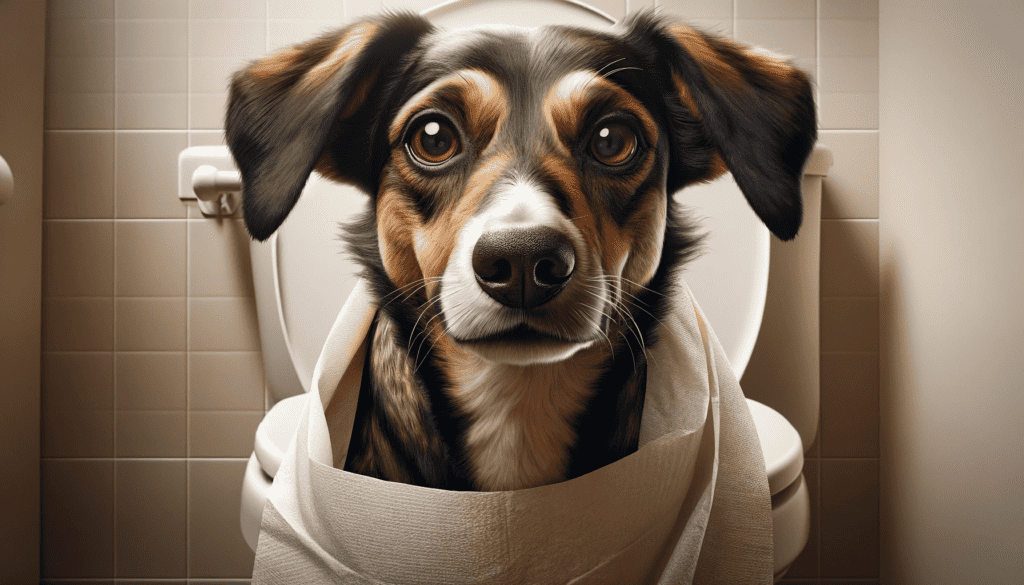
Food Allergies in Dogs: Common Cause of Dog Diarrhea
Understanding Food Allergies in Dogs
Food allergies occur when a dog’s immune system mistakenly identifies a specific food ingredient as harmful, leading to an allergic reaction. This reaction can manifest in various ways, from skin conditions to gastrointestinal disturbances, including diarrhea.
Common Allergens for Dogs
While any food can potentially cause an allergic response in sensitive dogs, there are some known culprits that often make their way to the top of the list:
- Proteins: Chicken, beef, and dairy are some of the most common food allergens for dogs. Other meats such as lamb or pork can also be problematic for some canines.
- Grains: Corn, wheat, and soy have been identified as common sources of allergies. This has led to an increase in grain-free diets, but it’s essential to consult with a veterinarian before making significant changes to your dog’s diet.
- Eggs: Some dogs can develop allergies to eggs or specifically the proteins within them.
- Additives and Fillers: Artificial colors, flavors, and certain preservatives can sometimes trigger allergic reactions in sensitive dogs.
How Food Allergies Manifest as Diarrhea in Dogs
When a dog ingests an allergen, the immune response can cause inflammation in the gastrointestinal tract. This inflammation disrupts the normal absorption of nutrients and can lead to increased water content in the intestines, resulting in diarrhea. The dog’s stool may be loose, more frequent, and sometimes contain mucus or blood.
Diagnosis and Treatment For Food Allergies in Dogs
Understanding and correctly diagnosing food allergies is crucial for providing the best care and treatment for your furry friend. Here’s a more detailed breakdown of the process and the treatment options available:
Diagnostic Process For Food Allergies in Dogs:
- Clinical History and Physical Examination:
- Review of the dog’s dietary history, including all foods and treats.
- Examination for other symptoms of allergies, such as skin irritations, itching, or ear infections.
- Elimination Diet:
- As mentioned, this involves feeding the dog a novel protein and carbohydrate source they haven’t been exposed to before.
- The trial usually lasts for 8-12 weeks. During this period, it’s essential not to give any other foods, treats, or flavored medications.
- If the symptoms resolve, each ingredient from the dog’s original diet is reintroduced one by one, monitoring for a recurrence of symptoms to pinpoint the offending allergen.
- Blood Tests:
- Some veterinarians may suggest blood tests to detect specific food antibodies. However, it’s worth noting that blood tests are not always as definitive or accurate as elimination diets.
- Hair and Saliva Testing:
- Hair and saliva testing are alternative methods used to identify potential allergies in dogs. These tests analyze specific proteins or markers in the hair and saliva to determine sensitivities to various allergens.
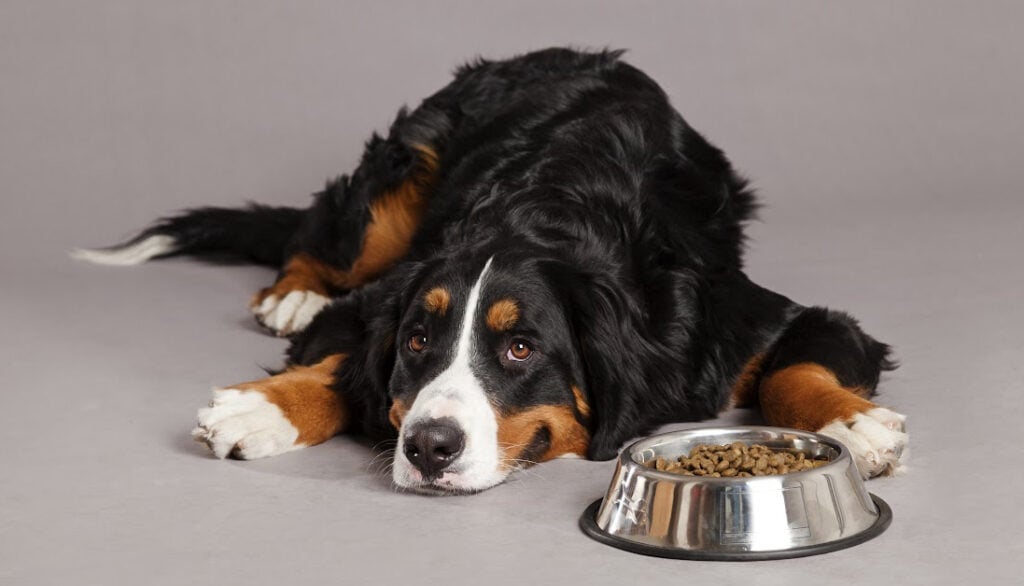
Treatment Options For Food Allergies in Dogs:
- Dietary Management:
- Once the allergenic ingredient is identified, it should be permanently eliminated from the dog’s diet.
- Commercially available hypoallergenic diets can be beneficial. These diets are either formulated with hydrolyzed proteins (where the protein is broken down into small, unrecognizable fragments) or novel proteins that the dog hasn’t been exposed to.
- Supplements:
- Omega-3 fatty acid supplements can help decrease inflammation and are beneficial for dogs with allergies.
- Probiotics can also assist in restoring the gut’s natural flora, especially if the dog’s digestive system has been affected.
- Medication:
- In some severe cases, where symptoms are extreme or causing distress, short-term medication might be prescribed to reduce inflammation or treat secondary infections that have arisen due to the allergy.
- Regular Monitoring:
- Regular check-ups with the veterinarian to ensure that the treatment is effective and that no new allergies have developed.
- Keeping a close eye on any new symptoms or a recurrence of diarrhea, itching, or any other signs.
While food allergies in dogs can be a challenging condition to navigate, with the right diagnostic tools and treatment methods, they can be managed effectively. Always consult with a veterinarian when making decisions about your dog’s health and diet.

Preventing Food Allergies in Dogs
Food allergies in dogs can be discomforting and sometimes even distressing. While it’s not always possible to prevent every allergy, there are strategies that dog owners can implement to minimize the risk and ensure their furry friends remain healthy.
1. Gradual Introduction of New Foods:
- Start Early: Begin introducing varied proteins and carbohydrates to puppies from a young age. This helps their immune system recognize and tolerate a broad range of food items.
- One at a Time: When introducing new foods, do it one by one. This way, if there’s a reaction, you’ll know exactly what caused it.
2. Quality Over Quantity:
- High-Quality Ingredients: Invest in high-quality dog foods that use wholesome ingredients without unnecessary fillers, artificial flavors, colors, or preservatives.
- Read Labels: Become familiar with reading pet food labels. Know what goes into your dog’s food and opt for natural and limited-ingredient diets when possible.
3. Avoid Overexposure:
- Rotate Proteins: Instead of feeding the same protein source (like chicken) continuously, rotate between different proteins every few months. This rotation can help prevent the overexposure that sometimes leads to the development of allergies.
- Diverse Diet: Encourage a diverse diet but ensure it is balanced and appropriate for your dog’s specific needs.
4. Probiotics and Digestive Enzymes:
- Boost Gut Health: Maintaining a healthy gut can be beneficial in preventing food sensitivities and allergies. Consider adding a canine-specific probiotic supplement to your dog’s diet.
- Digestive Enzymes: These can aid in breaking down food more effectively, reducing the chance of undigested food causing allergic reactions.
5. Monitor and Document:
- Keep a Food Diary: Make a note of what your dog eats and any reactions, even if they seem minor. This documentation can be invaluable in identifying potential issues early on.
- Regular Vet Visits: Ensure regular check-ups with the veterinarian. Discuss any concerns and get guidance on any dietary changes you’re considering.
6. Be Cautious with Treats and Scraps:
- Know the Ingredients: Just as with regular dog food, ensure that treats are made of high-quality ingredients. Avoid those with a long list of unrecognizable components.
- Limit Table Scraps: While it’s tempting to share our food with our dogs, many human foods contain ingredients that are allergenic to dogs. If you do share, make sure it’s safe and given in moderation.
7. Stay Updated on Pet Food Recalls:
- Safety First: Occasionally, specific batches of pet foods might get recalled due to contamination. Staying updated ensures that your dog is not exposed to potential allergens or contaminants.
In essence, while no strategy can guarantee the complete prevention of food allergies, these steps can significantly reduce the risk. Being proactive, observant, and maintaining open communication with your veterinarian are the cornerstones of ensuring your dog’s nutritional well-being.
Understanding the nuances of food allergies in dogs is crucial for their overall health and well-being. By being observant of changes in your dog’s behavior, stool consistency, and other symptoms, and consulting with your veterinarian, you can address and manage these allergies effectively. Remember, every dog is unique, so what works for one might not necessarily work for another. Tailoring their diet to their specific needs, with the guidance of a professional, is the key.

Ingesting Spoiled Food: A Culprit Behind Dog Diarrhea
While dogs often seem to have stomachs of steel, delving into trash bins or snatching up street-side morsels, their digestive systems aren’t invincible. One of the most common mistakes dogs make is ingesting spoiled food, leading to gastrointestinal issues, including diarrhea.
Why Dogs Eat Spoiled Food
- Natural Scavengers: By nature, dogs are scavengers, making them less discerning about food freshness or source.
- Enticing Smells: To a dog’s keen nose, the pungent aroma of spoiled food can be alluring, drawing them to consume it.
- Opportunistic Feeders: If food is accessible, especially when unsupervised, many dogs will eat first and “think” later.
Dangers of Consuming Spoiled Food
- Bacterial Growth: Spoiled food can harbor harmful bacteria such as Salmonella or E. coli, which can cause severe gastrointestinal disturbances.
- Toxins: As some foods spoil, they produce toxins. For example, molds on certain foods produce mycotoxins which can be harmful when ingested.
- Foreign Objects: Dogs rummaging through garbage for food might inadvertently swallow non-food items, causing internal obstructions or injuries.
- Chemical Contamination: Spoiled foods, especially those from trash bins, might be in contact with other chemicals or toxic substances.

Symptoms Post Ingestion
- Diarrhea: Often the most immediate and evident symptom.
- Vomiting: Some dogs might throw up, especially if the food was particularly toxic.
- Lethargy: A general lack of energy or enthusiasm.
- Loss of Appetite: The dog may refuse to eat, even their favorite treats.
- Abdominal Pain: The dog may show signs of discomfort or pain in the belly area, often noticeable by a hunched back or sensitivity to touch.
Immediate Interventions
- Remove Access: Ensure the dog no longer has access to the source of the spoiled food.
- Hydration: Make sure your dog has access to clean water, especially if vomiting or diarrhea occurs.
- Do Not Induce Vomiting Unless Advised: Some toxins or objects can cause more harm if regurgitated. Always consult with a veterinarian before taking any action.
- Monitor Closely: Watch your dog for any worsening symptoms or signs of distress.
Prevention Strategies
- Secure Trash Cans: Invest in dog-proof trash cans or store them in areas inaccessible to your dog.
- Regularly Clean Food Bowls: Ensure your dog’s food bowls are cleaned regularly to prevent old or spoiled food remnants.
- Proper Food Storage: Store dog food in cool, dry places and use it before the expiration date.
- Supervise Outdoor Time: When outside, especially in new or unfamiliar areas, keep a close eye on your dog to prevent them from scavenging.
Ingesting spoiled food can cause immediate discomfort for dogs and lead to more severe complications. Awareness and proactive measures are the best strategies to ensure your dog stays safe and healthy. Always consult with a veterinarian if you suspect your dog has consumed spoiled or potentially harmful food.

Intestinal Parasites in Dogs: Top Cause of Dog Diarrhea
Intestinal parasites are all too common in the canine world. These unwelcome guests can cause a range of health issues, with diarrhea being one of the most prevalent symptoms. Recognizing, treating, and preventing these parasites is crucial for maintaining your dog’s overall health.
Common Intestinal Parasites in Dogs
Dogs, being curious creatures, often come into contact with a variety of organisms during their adventures. Among these, certain unwelcome invaders might set up residence in their intestines. Let’s delve into the most common intestinal parasites that our canine companions might encounter.
- Roundworms (Toxocara canis): These are long, spaghetti-like worms that primarily affect puppies but can be found in dogs of all ages.
- Hookworms: Small and thin, these parasites attach to the intestinal wall and feed on the dog’s blood, often causing anemia.
- Whipworms: Found primarily in the large intestine, they can lead to inflammation and bloody diarrhea.
- Tapeworms: Segmented worms that are often visible in the dog’s feces or around their rear end. They are commonly contracted through fleas.
- Giardia and Coccidia: These are not worms but single-celled parasites that infect the intestines, leading to watery diarrhea.
How Dogs Get Infected with Intestinal Parasites
You might wonder, given the care and attention we shower on our pets, how do they end up contracting these parasitic infections? The avenues of infection are more common than one might assume. Here’s a breakdown of how dogs typically get infected by these microscopic troublemakers.
- Environmental Exposure: Many of these parasites lay eggs that are excreted in the feces of infected animals. Dogs can become infected by ingesting contaminated soil, water, or feces.
- Intermediate Hosts: Some parasites, like tapeworms, require an intermediate host, like fleas. When a dog consumes the intermediate host, they get infected.
- Mother to Pup: Puppies can get parasites like roundworms through their mother’s milk.
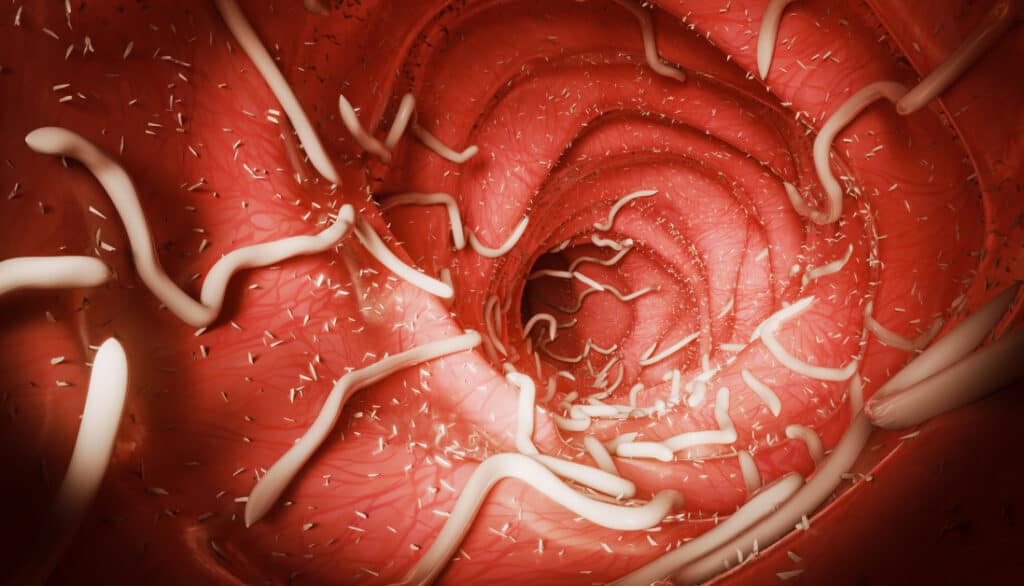
Symptoms of Intestinal Parasites in Dogs
A dog infected with parasites might not always exhibit noticeable symptoms immediately. However, as the infestation progresses, certain tell-tale signs begin to emerge. Being able to recognize these early on can be key to timely intervention and treatment.
- Diarrhea: Can be watery, bloody, or mucus-filled depending on the parasite.
- Weight Loss: Even if the dog is eating normally.
- Bloated or Rounded Belly: Especially noticeable in puppies.
- Visible Worms: In the feces or around the dog’s rear.
- Lethargy: Due to nutrient malabsorption or anemia.
- Scratching or “Scooting”: Caused by irritation around the anal area.
Diagnosis and Treatment of Intestinal Parasites in Dogs
Identifying a parasitic infection in its early stages can be the difference between a quick recovery and a prolonged ailment. Armed with the right knowledge and tools, veterinarians can diagnose and combat these intestinal invaders effectively. Let’s understand the process of diagnosis and the subsequent treatment steps.
- Fecal Examination: Veterinarians will often analyze a fecal sample under a microscope to identify the type and severity of the parasite infestation.
- Deworming Medications: Once identified, your vet will prescribe the appropriate deworming medication. Some parasites may require specific treatments, while others can be addressed with broad-spectrum dewormers.
- Repeat Treatments: Some parasites have life cycles that aren’t immediately eradicated by one round of medication, so repeat treatments might be necessary.
- Supportive Care: In severe cases, additional care like hydration therapy or nutritional support may be required.
Preventing Intestinal Parasites in Dogs
They say prevention is better than cure, and when it comes to parasitic infections in dogs, this adage holds true. Proactive measures can greatly reduce the chances of your dog contracting these pesky parasites. Dive into the essential steps to keep your furry friend safe and healthy.
- Regular Vet Check-ups: Routine fecal examinations can catch infestations early.
- Hygiene: Promptly clean up after your dog to minimize environmental contamination.
- Safe Play Areas: Ensure your dog’s play areas are free from feces, especially if frequented by other animals.
- Flea Prevention: Since fleas are an intermediate host for some parasites, keeping your dog flea-free can reduce the risk.
- Proper Food Handling: If you feed your dog raw food, ensure it’s sourced from reputable places and handled with care.
Intestinal parasites are a common issue but with vigilance, timely treatment, and preventive measures, their impact can be minimized. Regular vet visits and being attentive to your dog’s behavior and health are your best defenses against these pesky invaders.

Bacterial Infections in Dogs: Leading to Dog Diarrhea
The canine digestive system, much like our own, is a delicate balance of beneficial and harmful bacteria. When this balance is disrupted, bacterial infections can manifest, often leading to symptoms such as diarrhea. This section explores the common bacterial culprits, their causes, symptoms, and what can be done to treat and prevent them.
Common Bacterial Culprits
Our dogs’ digestive tracts are bustling communities of bacteria, most of which coexist peacefully and even contribute to their health. However, when pathogenic bacteria overtake or invade this ecosystem, the outcome can be distressing. Let’s identify the main bacterial offenders that can lead to diarrhea in dogs.
- Salmonella: Often contracted through contaminated food or water, this bacteria can cause severe gastrointestinal symptoms.
- E. coli: Found naturally in the intestines, it becomes problematic when certain harmful strains proliferate or are ingested.
- Campylobacter: This bacteria is commonly transmitted through raw or undercooked poultry and can lead to intense bouts of diarrhea.
- Clostridium perfringens: Normally present in small amounts, issues arise when it multiplies rapidly, releasing toxins in the process.
How Dogs Contract Bacterial Infections
While we take various measures to keep our furry friends safe, the world they interact with is teeming with bacteria. Some of these are beneficial, while others are potential threats. Delving into the ways dogs get exposed can help us better protect them from these invisible assailants.
- Contaminated Food and Water: Consumption of spoiled food or water contaminated by feces can introduce harmful bacteria.
- Contact with Infected Animals: Interaction with other infected animals or their waste can be a source of transmission.
- Unsanitary Conditions: Living or playing in dirty environments can expose dogs to a myriad of harmful bacteria.
- Weak Immune System: Dogs with compromised immune systems are more susceptible to infections.

Symptoms of Bacterial Infections in Dogs
Like any ailment, bacterial infections leave their mark, often presenting a spectrum of symptoms that signal something’s amiss. Recognizing these signs is the first step in providing our pets the relief and care they need.
- Diarrhea: Often the most prominent sign, it can vary from mild to severe, sometimes containing blood or mucus.
- Vomiting: Some bacterial infections also induce nausea and vomiting.
- Fever: A rise in body temperature can indicate the body’s attempt to fight off the infection.
- Lethargy: The dog may appear tired or uninterested in regular activities.
- Loss of Appetite: A reduced interest in food, even favorites, can be a concerning sign.
Treatment and Recovery For Bacterial Infections in Dogs
When our beloved pets fall victim to bacterial infections, time is of the essence. The right interventions can be the difference between a swift recovery and prolonged distress. Here’s an insight into how veterinarians approach these infections and the path to healing.
- Fecal Examination: A stool sample can help identify the bacteria causing the issue.
- Antibiotics: Once diagnosed, the vet may prescribe specific antibiotics to combat the bacterial infection.
- Probiotics: To restore gut health and balance, probiotics can be beneficial during and after antibiotic treatment.
- Supportive Care: Hydration and nutritional support can expedite the recovery process, especially in severe cases.
Prevention Measures For Bacterial Infections in Dogs
As the saying goes, “An ounce of prevention is worth a pound of cure.” In the realm of bacterial infections in dogs, this couldn’t be truer. Here, we’ll explore the actionable steps that every dog owner can take to minimize the risk of these infections.
- Hygienic Living Conditions: Regular cleaning of living areas and ensuring access to clean water.
- Safe Food Practices: Store dog food correctly and avoid feeding spoiled or questionable food.
- Regular Vet Check-ups: Regular visits can catch and address potential issues early.
- Vaccinations: Some bacterial infections can be prevented with appropriate vaccinations.
Bacterial infections, though common, can be effectively managed with timely intervention. By understanding the causes and being proactive in prevention, dog owners can ensure the health and happiness of their four-legged companions.

Viral Infections in Dogs: A Prominent Cause of Dog Diarrhea
Viruses, unlike bacteria, are not living entities in the conventional sense, yet they can wreak havoc when they invade a host’s body, including our canine companions. Several viral infections can cause diarrhea in dogs, with varying degrees of severity. This section delves deep into understanding these viruses, their transmission, symptoms, treatment, and prevention.
Prominent Viral Culprits
In the intricate web of canine health, viruses stand as potent threats, sometimes hidden but always impactful. While a myriad of viruses can affect dogs, a select few are notorious for causing gastrointestinal distress. Let’s shine a light on these viral agents to better understand and combat them.
- Canine Parvovirus: A highly contagious virus that often strikes puppies, leading to severe, bloody diarrhea and other complications.
- Canine Coronavirus: Though not as severe as parvovirus, this virus can still cause diarrhea, especially when combined with other pathogens.
- Canine Distemper: While primarily known for respiratory symptoms, it can also cause gastrointestinal issues in dogs.
- Adenovirus: Commonly affects puppies, leading to mild diarrhea but is generally self-limiting.
How Dogs Contract Viral Infections
In our interconnected world, where dogs explore, play, and interact, the pathways for viral transmissions are multifold. By understanding how these microscopic invaders spread, we can better safeguard our furry companions from their grasp. Here’s how our four-legged friends typically get exposed to these infectious agents:
- Direct Contact: Interaction with an infected dog can transmit viruses, especially through nasal and mouth secretions.
- Fomites: Inanimate objects like bowls, toys, or shoes can carry the virus if contaminated.
- Contaminated Environment: Some viruses can survive in the environment for extended periods, waiting for a host.
- Infected Wildlife: Certain viruses, like distemper, can be transmitted by wildlife carriers.
Symptoms of Viral Infections
The silent onset of viral infections can be unsettling, as they often manifest before we’re even aware. Recognizing the tell-tale signs of a viral invasion in its nascent stages is the first step toward providing timely care and relief to our pets.
Different viruses will manifest varying symptoms, but some common signs indicate a possible viral infection:
- Diarrhea: Ranging from mild to severe, it can sometimes be bloody or mucus-filled.
- Vomiting: Many viral infections also lead to frequent vomiting in dogs.
- Fever: Elevated body temperature suggests the body is fighting off an invader.
- Lethargy: Infected dogs may appear sluggish and show diminished interest in activities.
- Appetite Loss: Affected dogs may eat less or refuse food altogether.
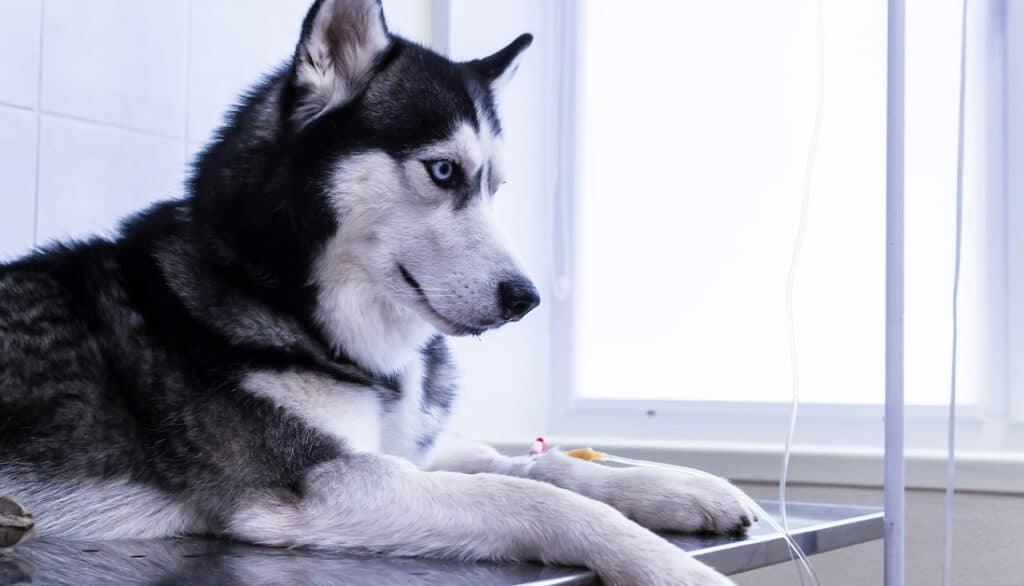
Treatment and Recovery
While viruses themselves are not “alive” in the traditional sense, their capacity to disrupt life is undeniable. Combatting these pathogens isn’t about destruction but about support, care, and management. Let’s explore the best practices in helping a dog recover from a viral onslaught.
Contrary to bacterial infections, viral ones can’t be “cured” with medications, but supportive care plays a pivotal role:
- Supportive Care: This includes maintaining hydration, nutritional support, and addressing secondary bacterial infections if they arise.
- Isolation: To prevent the spread, infected dogs should be kept away from other animals until recovery.
- Vaccination: Some viral infections, once contracted, can provide immunity, but preventive vaccinations remain the best defense.
- Regular Monitoring: Frequent check-ups post-recovery ensure no lingering effects or complications.
Preventing Viral Infections in Dogs
In the world of viruses, the best defense is often a proactive offense. As guardians of our canine companions, understanding and employing preventive strategies can drastically reduce the risks they face from these infectious agents.
Preventing viral infections is crucial, given their potential severity and rapid spread:
- Regular Vaccinations: Staying up-to-date with recommended vaccines significantly reduces the risk of many viral infections.
- Hygiene: Disinfecting common areas, toys, and bowls can curb the spread of viruses.
- Avoid High-Risk Areas: Limiting exposure in places with known outbreaks or high dog populations can be beneficial.
- Prompt Veterinary Care: At the first sign of symptoms, seeking veterinary attention can help in early diagnosis and management.
Viral infections in dogs, while intimidating, can be managed and often prevented. Knowledge, timely interventions, and preventive measures are paramount in ensuring our dogs remain healthy, vibrant, and by our side for years to come.

Stress-Induced Diarrhea in Dogs: Causes and Solutions
While physical ailments like infections and allergies often come to mind when we think of health issues in dogs, mental well-being is equally paramount. Stress, though intangible, can manifest in very tangible ways, including diarrhea. In this section, we’ll unravel the connection between stress and gastrointestinal issues in dogs, pinpointing causes and offering solutions for both immediate relief and long-term well-being.
Understanding Stress in Dogs
Much like humans, dogs can experience stress, anxiety, and emotional discomfort. While they might not grapple with financial worries or existential crises, their world is filled with stimuli and scenarios that can induce stress. Recognizing what constitutes stress for a dog is the first step towards alleviating it.
- Changes in Environment: Moving homes, alterations in living space, or even redecorating can be unsettling.
- New Faces or Loss: The introduction of new pets or family members, or the loss of a companion can evoke stress.
- Loud Noises: Thunderstorms, fireworks, and loud urban sounds can be frightening to many dogs.
- Routine Disruptions: Changes in feeding times, walks, or prolonged absences of family members can induce anxiety.
Linking Stress to Diarrhea in Dogs
The interplay between mind and body isn’t exclusive to humans; dogs too bear the brunt of emotional disturbances on their physical well-being. The connection between stress and digestive health is both intriguing and critical. Here’s how stress can affect the digestive system:
- Fight or Flight Response: Stress can trigger this ancient response, diverting blood away from the digestive system, leading to diarrhea.
- Gut Flora Imbalance: Prolonged stress can disrupt the balance of beneficial bacteria in the gut.
- Overactivity in the Digestive Tract: Anxiety can speed up digestive processes, leading to diarrhea.
Identifying Stress-Induced Diarrhea in Dogs
In the maze of canine health, discerning the true cause behind a symptom can be challenging. With various factors potentially leading to diarrhea, how do we pinpoint stress as the culprit? Before attributing diarrhea to stress, it’s essential to rule out other potential causes. Some indicators suggest stress might be the culprit:
- Occurrence in Stressful Situations: Diarrhea that tends to appear during thunderstorms, family gatherings, or other stress-inducing scenarios.
- Absence of Other Symptoms: If the dog doesn’t show signs of infections or allergies, stress could be the cause.
- Behavioral Signs: Alongside diarrhea, signs like excessive licking, panting, or hiding can indicate stress.

Solutions and Management For Stress-Induced Diarrhea in Dogs
Addressing stress-induced ailments in dogs isn’t merely about treating the symptom; it’s about holistic well-being. Tending to a dog’s emotional health requires a blend of immediate interventions and long-term strategies:
- Safe Spaces: Create a calming environment or a dedicated space where the dog can retreat during stressful events.
- Routine: Keeping feeding, walks, and playtime consistent can provide a comforting structure.
- Probiotics: Supporting gut health can mitigate the impact of stress on the digestive system.
- Calming Aids: Consider natural calming supplements, toys, or even anxiety wraps to soothe the dog.
- Professional Help: For chronic stress, consulting with a vet or a pet behaviorist might be necessary.
Stress-induced diarrhea in dogs serves as a poignant reminder that their emotional well-being is intricately linked to their physical health. By understanding, recognizing, and addressing the root causes of stress, we can foster an environment where our dogs thrive emotionally and physically.

Medications Causing Dog Diarrhea: What Every Dog Owner Needs to Know
Pharmaceutical interventions, while undeniably beneficial in addressing a range of health issues in dogs, can sometimes come with their set of challenges. One such challenge that many dog owners encounter is diarrhea as a side effect of certain medications. This section aims to provide a comprehensive understanding of this phenomenon, enabling informed decisions and proactive care when our pets are on medication.
Why Some Medications Cause Diarrhea
Medications are designed to elicit specific responses in the body, but they often interact with various physiological processes, leading to unintended effects. Here’s why certain drugs might cause diarrhea in dogs:
- Direct Impact on the Gut: Some medications can irritate the lining of the intestines or alter gut motility.
- Disruption of Gut Flora: Antibiotics, for instance, can disrupt the balance of good bacteria in the intestines.
- Systemic Reactions: Some drugs might cause diarrhea as a broader reaction involving multiple body systems.
Common Culprits: Drugs Known to Cause Diarrhea
While any medication can potentially cause diarrhea, certain drugs have been more frequently associated with this side effect:
- Antibiotics: Especially broad-spectrum ones, can affect gut bacteria balance.
- Non-Steroidal Anti-Inflammatory Drugs (NSAIDs): These can sometimes irritate the gut lining.
- Heartworm Medications: Some preventive heartworm drugs can lead to gastrointestinal issues.
- Chemotherapy Drugs: Used for treating cancers, they can often lead to digestive upset.
Managing Diarrhea Caused by Medications
If you suspect your dog’s diarrhea is linked to a medication, here are steps to consider:
- Consult Your Vet: Never stop or change a medication without consulting with the veterinarian.
- Dietary Adjustments: Offering a bland diet can help soothe the digestive system.
- Probiotics: Introducing good bacteria can help in restoring gut flora balance.
- Monitor for Other Side Effects: Watch out for any other unusual behaviors or symptoms.
Prevention and Proactive Care
While it might not always be possible to prevent medication-induced diarrhea, some steps can mitigate its likelihood:
- Gradual Introduction: If possible, introduce new medications gradually to allow the body to adjust.
- Use Targeted Antibiotics: Instead of broad-spectrum, specific antibiotics can minimize gut flora disruption.
- Regular Health Checks: Periodic vet visits can help in monitoring any side effects of long-term medications.
Pharmaceutical interventions are often a necessary component of canine health. Yet, as with everything, they come with their set of challenges. Being informed, observant, and proactive can make all the difference, ensuring our dogs derive the maximum benefit from medications while minimizing potential discomforts.

Dietary Changes and Dog Diarrhea: Key Points to Be Aware Of
Nutrition plays a pivotal role in the overall well-being of our dogs. Just as the food we eat can significantly impact our health, the same holds true for our canine companions. While dietary changes are sometimes necessary, they can occasionally lead to digestive upsets, with diarrhea being a common symptom. This section seeks to shed light on the delicate interplay between diet and digestion in dogs, offering insights and solutions for those navigating dietary transitions.
Understanding the Canine Digestive System
Before delving into the impact of dietary changes, it’s crucial to have a grasp of a dog’s digestive anatomy and physiology:
- Digestive Tract Design: Dogs have a relatively short digestive tract, designed for meat consumption but adaptable to a varied diet.
- Gut Flora: A balanced mix of beneficial bacteria aids in digestion, immune function, and overall gut health.
- Digestive Enzymes: These are crucial for breaking down food components, and their levels can vary based on diet.
Why Dietary Changes Can Cause Diarrhea
Switching foods or introducing new dietary components might seem straightforward, but even minor changes can impact digestion:
- Rapid Transition: Suddenly changing a dog’s diet doesn’t give the digestive system enough time to adjust.
- Ingredient Sensitivity: New foods might contain ingredients that a dog is sensitive or allergic to.
- Change in Nutrient Ratios: A drastic change in protein, fat, or fiber ratios can disrupt digestion.
- Quality of Ingredients: Lower quality or spoiled food can irritate the digestive system.
Safely Transitioning to a New Diet
For those looking to switch their dog’s diet or introduce new foods, here’s a guide to ensure a smooth transition:
- Gradual Change: Start by mixing a small portion of the new food with the old, gradually increasing the new food’s proportion over 7-10 days.
- Monitor for Reactions: Keep an eye out for any signs of digestive upset, allergies, or behavioral changes.
- Seek High-Quality Foods: Prioritize quality, ensuring the food sources are reputable and the ingredients are fresh.
- Hydration: Ensure your dog has access to plenty of fresh water, especially if showing signs of diarrhea.
When to Consult a Vet
While mild and short-lived diarrhea following a diet change can be typical, it’s essential to recognize when professional help is required:
- Persistent Diarrhea: If it continues for more than 48 hours.
- Other Symptoms: Such as vomiting, lethargy, or loss of appetite.
- Blood in Stool: This can indicate more severe digestive issues or internal injuries.
- Signs of Dehydration: Such as sunken eyes, dry gums, or excessive panting.
Food is more than just fuel; it’s the foundation of health. As dog owners, ensuring our pets receive optimal nutrition, tailored to their specific needs, is paramount. By understanding the intricacies of the canine digestive system and being mindful during dietary transitions, we can pave the way for a happy and healthy life for our four-legged friends.
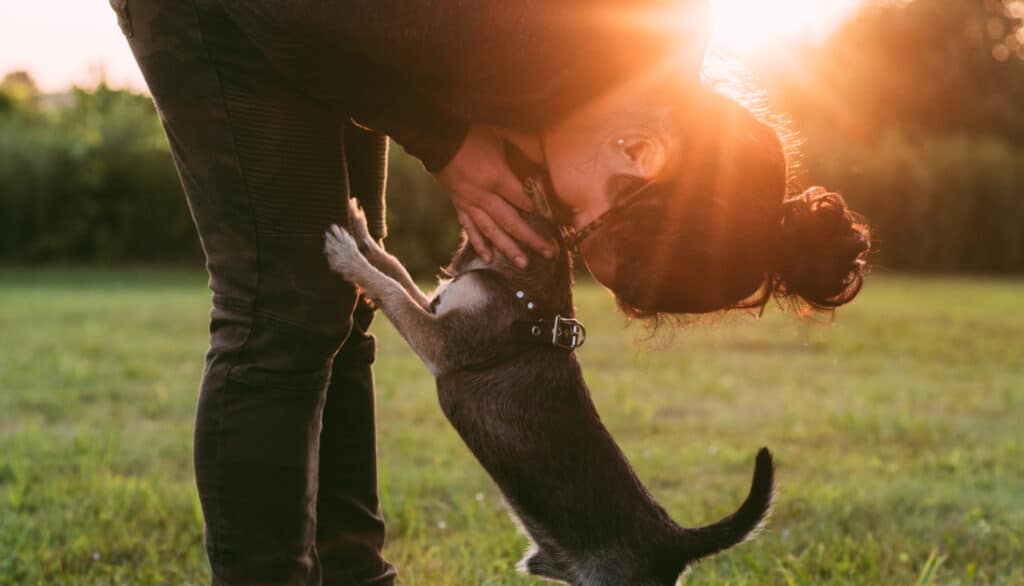
Conclusion
In the vast and intricate world of canine health, the proverbial saying, “knowledge is power,” couldn’t be more apt. From the nuances of dietary changes to the intricate dance of medications, our journey through the causes of diarrhea in dogs has underscored the importance of informed decision-making. Every pet owner, armed with the right information, becomes a pivotal player in their dog’s well-being.
As we’ve seen, while some causes of diarrhea are relatively harmless and short-lived, others demand immediate attention and intervention. The balance lies in discerning which is which, and in that balance resides the health and happiness of our furry companions. It’s not just about mitigating the uncomfortable moments, but about enhancing the quality of life they lead every day.
As responsible guardians, our aim should always be to provide a nurturing environment, replete with the best nutrition, timely medical care, and above all, an abundance of love. The bond between humans and dogs is ancient, sacred, and built on mutual trust. By staying educated, proactive, and compassionate, we don’t just address immediate health concerns; we fortify this bond, ensuring that our dogs lead lives as joyous and fulfilling as the memories they gift us.
Thank you for joining me on this exploration. May every dog lover carry forth this knowledge, making the world a better place, one wagging tail at a time.
Frequently Asked Questions
A: While returning to a familiar diet can often alleviate symptoms, some dogs might still experience persistent diarrhea due to residual inflammation, a lasting imbalance in gut flora, or other underlying health issues. If diarrhea continues for more than 48 hours, it’s essential to consult a veterinarian to rule out other causes and receive targeted treatment.
A: Yes, some breeds, such as Golden Retrievers, Cocker Spaniels, and German Shepherds, have been observed to exhibit higher instances of food sensitivities or allergies. However, any dog, regardless of breed, can develop allergies or sensitivities. It’s essential to monitor for signs and consult a vet if symptoms arise.
A: Symptoms from ingesting spoiled food, like diarrhea or vomiting, can appear within a few hours to 48 hours post-ingestion. It’s crucial to monitor your dog closely for any signs of discomfort or illness and seek veterinary care if symptoms are severe or persistent.
A: Stress-induced diarrhea can be both a one-time event, triggered by a sudden stressful situation (like a move or loud noises), or a recurring issue due to chronic stress factors (like separation anxiety or frequent changes in the environment). Identifying and addressing the root cause of the stress is crucial for effective management.
A: If you believe a medication is causing diarrhea or any other side effect, it’s essential to consult your vet immediately. Additionally, regular health check-ups, at least once a year or as recommended by your vet, can help monitor your dog’s reaction to long-term medications and adjust dosages or types as necessary.
